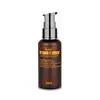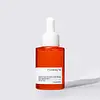What's inside
What's inside
 Key Ingredients
Key Ingredients

 Benefits
Benefits

 Concerns
Concerns

No concerns
 Ingredients Side-by-side
Ingredients Side-by-side

Sodium Hyaluronate
HumectantAscorbic Acid 5%
Antioxidant1,2-Hexanediol
Skin ConditioningNiacinamide
SmoothingArginine
MaskingNelumbo Nucifera Flower Extract
Skin ConditioningMagnolia Liliflora Bud Extract
Skin ConditioningLilium Tigrinum Extract
Skin ConditioningPaeonia Lactiflora Root Extract
Skin ConditioningTuber Magnatum Extract
Skin ConditioningPyrus Malus Fruit Extract
Skin ConditioningPanax Ginseng Root Extract
EmollientBrassica Oleracea Italica Extract
AstringentAnanas Sativus Fruit Extract
Skin ConditioningCurcuma Longa Root Extract
MaskingSodium Polyacrylate
AbsorbentAdenosine
Skin ConditioningDisodium EDTA
Sodium Hyaluronate, Ascorbic Acid 5%, 1,2-Hexanediol, Niacinamide, Arginine, Nelumbo Nucifera Flower Extract, Magnolia Liliflora Bud Extract, Lilium Tigrinum Extract, Paeonia Lactiflora Root Extract, Tuber Magnatum Extract, Pyrus Malus Fruit Extract, Panax Ginseng Root Extract, Brassica Oleracea Italica Extract, Ananas Sativus Fruit Extract, Curcuma Longa Root Extract, Sodium Polyacrylate, Adenosine, Disodium EDTA
Water
Skin ConditioningMethylpropanediol
SolventGlycerin
Humectant1,2-Hexanediol
Skin ConditioningNiacinamide
SmoothingPanthenol
Skin ConditioningBetaine
HumectantAcrylates/C10-30 Alkyl Acrylate Crosspolymer
Emulsion StabilisingTromethamine
BufferingGlycereth-25 PCA Isostearate
EmulsifyingAllantoin
Skin ConditioningPearl Extract
AntioxidantDipropylene Glycol
HumectantXanthan Gum
EmulsifyingSodium Citrate
BufferingAdenosine
Skin ConditioningEthylhexylglycerin
Skin ConditioningDisodium EDTA
Butylene Glycol
HumectantPolyglyceryl-10 Myristate
Skin ConditioningCitric Acid
BufferingGluconolactone
Skin ConditioningSodium Hyaluronate
HumectantCetyl Ethylhexanoate
EmollientCaprylic/Capric Triglyceride
MaskingCaprylyl Glycol
EmollientEthylhexyl Palmitate
EmollientChrysanthemum Morifolium Flower Extract
Skin ConditioningHydrolyzed Hyaluronic Acid
HumectantHydroxypropyltrimonium Hyaluronate
Broussonetia Kazinoki Root Extract
Skin ConditioningPentylene Glycol
Skin ConditioningSodium Hyaluronate Crosspolymer
HumectantSodium Acetylated Hyaluronate
HumectantHyaluronic Acid
HumectantAscorbic Acid
AntioxidantWater, Methylpropanediol, Glycerin, 1,2-Hexanediol, Niacinamide, Panthenol, Betaine, Acrylates/C10-30 Alkyl Acrylate Crosspolymer, Tromethamine, Glycereth-25 PCA Isostearate, Allantoin, Pearl Extract, Dipropylene Glycol, Xanthan Gum, Sodium Citrate, Adenosine, Ethylhexylglycerin, Disodium EDTA, Butylene Glycol, Polyglyceryl-10 Myristate, Citric Acid, Gluconolactone, Sodium Hyaluronate, Cetyl Ethylhexanoate, Caprylic/Capric Triglyceride, Caprylyl Glycol, Ethylhexyl Palmitate, Chrysanthemum Morifolium Flower Extract, Hydrolyzed Hyaluronic Acid, Hydroxypropyltrimonium Hyaluronate, Broussonetia Kazinoki Root Extract, Pentylene Glycol, Sodium Hyaluronate Crosspolymer, Sodium Acetylated Hyaluronate, Hyaluronic Acid, Ascorbic Acid
 Reviews
Reviews

Alternatives
Ingredients Explained
These ingredients are found in both products.
Ingredients higher up in an ingredient list are typically present in a larger amount.
1,2-Hexanediol is a synthetic liquid and another multi-functional powerhouse.
It is a:
- Humectant, drawing moisture into the skin
- Emollient, helping to soften skin
- Solvent, dispersing and stabilizing formulas
- Preservative booster, enhancing the antimicrobial activity of other preservatives
Adenosine is in every living organism. It is one of four components in nucleic acids that helps store our DNA.
Adenosine has many benefits when used. These benefits include hydrating the skin, smoothing skin, and reducing wrinkles. Once applied, adenosine increases collagen production. It also helps with improving firmness and tissue repair.
Studies have found adenosine may also help with wound healing.
In skincare products, Adenosine is usually derived from yeast.
Learn more about AdenosineAscorbic Acid is is pure Vitamin C. This form makes up the largest amount of vitamin C found naturally in our skin.
Not only is vitamin C great for your overall health and immune system, it also has plenty of benefits on your skin.
Vitamin C is best used for brightening skin. It improves dark spots, acne scars, and hyperpigmentation. This is because it blocks the process of skin darkening when exposed to UV.
Remember: Vitamin C should not replace sunscreen!
Your skin uses vitamin C to build collagen. Collagen is one key component in having a strong skin barrier and plump skin. Vitamin C also plays a role in regulating collagen, thus making it effective in improving wrinkles and fine lines.
Ascorbic acid shows potent antioxidant activity. As an antioxidant, it helps fight free-radicals. Free-radicals are molecules that may damage your skin cells. These antioxidants also protect skin against UV damage.
The best formulations include Vitamin E and/or ferulic acid. These two ingredients help stabilize and provide a boost in the benefits of ascorbic acid. This is because ascorbic acid becomes unstable when exposed to UV and air. In fact, you can tell your ascorbic acid has oxidized when it turns an orange-yellow color.
Ascorbic acid is generally compatible with other ingredients. However, using ascorbic acid with other active ingredients might cause irritation. Two ingredients: copper ions and benzoyl peroxide, will inactivate ascorbic acid completely.
Read more about other types of Vitamin C:
Foods rich with vitamin C include oranges, strawberries, broccoli, bell peppers, and more. When consuming Vitamin C, your skin receives a portion of the nutrients.
Learn more about Ascorbic AcidDisodium EDTA plays a role in making products more stable by aiding other preservatives.
It is a chelating agent, meaning it neutralizes metal ions that may be found in a product.
Disodium EDTA is a salt of edetic acid and is found to be safe in cosmetic ingredients.
Learn more about Disodium EDTANiacinamide is a multitasking form of vitamin B3 that strengthens the skin barrier, reduces pores and dark spots, regulates oil, and improves signs of aging.
And the best part? It's gentle and well-tolerated by most skin types, including sensitive and reactive skin.
You might have heard of "niacin flush", or the reddening of skin that causes itchiness. Niacinamide has not been found to cause this.
In very rare cases, some individuals may not be able to tolerate niacinamide at all or experience an allergic reaction to it.
If you are experiencing flaking, irritation, and dryness with this ingredient, be sure to double check all your products as this ingredient can be found in all categories of skincare.
When incorporating niacinamide into your routine, look out for concentration amounts. Typically, 5% niacinamide provides benefits such as fading dark spots. However, if you have sensitive skin, it is better to begin with a smaller concentration.
When you apply niacinamide to your skin, your body converts it into nicotinamide adenine dinucleotide (NAD). NAD is an essential coenzyme that is already found in your cells as "fuel" and powers countless biological processes.
In your skin, NAD helps repair cell damage, produce new healthy cells, support collagen production, strengthen the skin barrier, and fight environmental stressors (like UV and pollution).
Our natural NAD levels start to decline with age, leading to slower skin repair, visible aging, and a weaker skin barrier. By providing your skin niacinamide, you're recharging your skin's NAD levels. This leads to stronger, healthier, and younger looking skin.
Another name for vitamin B3 is nicotinamide. This vitamin is water-soluble and our bodies don't store it. We obtain Vitamin B3 from either food or skincare. Meat, fish, wheat, yeast, and leafy greens contain vitamin B3.
The type of niacinamide used in skincare is synthetically created.
Learn more about NiacinamideSodium Hyaluronate is hyaluronic acid's salt form. It is commonly derived from the sodium salt of hyaluronic acid.
Like hyaluronic acid, it is great at holding water and acts as a humectant. This makes it a great skin hydrating ingredient.
Sodium Hyaluronate is naturally occurring in our bodies and is mostly found in eye fluid and joints.
These are some other common types of Hyaluronic Acid:
Learn more about Sodium Hyaluronate